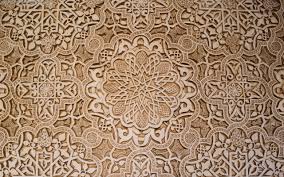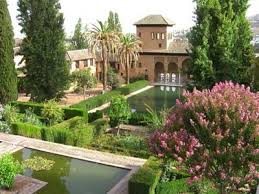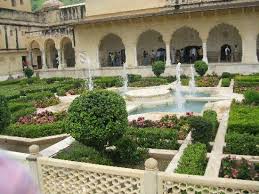
Even though the traveler is often
far from home, in search of the new, the fundamental challenge that presents
itself to this individual is how to understand the varying sights that
confronts her. Over time, the collection of a greater store of experiences
allows the traveler to compare new situations with a diversity of experiences
from across different worlds. In the beginning however, the traveler is
restricted to understanding the new, by comparing the situation before her to
situations experienced in her natal environment (what some people would like to
call home).

There is something of this
familiarity that assails the South Asian traveler when in parts of southern
Europe, in particular the lovingly restored remains of the Moorish presence in
the Iberian Peninsula. Take for example the responses of so many South Asians
who have traveled to the Alhambra palaces in the Spanish city of Granada. What
is an overpoweringly exotic location to visitors from either Europe of the
Americas, is vaguely reminiscent of home to the traveled South Asian. This
home is the idiom of Mughal architecture, and following them the Indo-Saracenic
edifices raised by the British Raj. Both architectural idioms combine similar
vocabularies, encompassing pillars and arches, rooms around courtyards, flowing
water within these rooms, and pools within these courtyards. Where the Mughals
would employ
pietra dura, the
Andalusians, and the Iberians who followed them, use
azulejos, brightly coloured tiles to animate the walls of the
rooms.

There is however a difference
between the palaces of the Alhambra and the Mughal palaces in Agra and Delhi.
This difference pertains to the spaces between the monuments. In the case of
the Alhambra the caretakers of these edifices realized that the palaces
consisted not merely of the built structures but of the garden spaces that not
only enveloped the buildings but gave life to its very heart. A great deal of
effort has gone into detailed historically accurate reconstruction of the
gardens of the Alhambra, and the results are spectacular. Indeed, walking
around these gardens, and armed with the details that we know about the Mughal
palaces, one can then re-imagine what the Mughal palaces would have looked like
in their splendor. This experience is somewhat strange, because it compounds
the experience of being vaguely at home, with another experience, that of
filling in the gaps, and imagining what “home” must have been like!

Unfortunately for us in India,
the garden spaces in the Mughal fort-palaces are now animated by British Raj inspired
gardens, rather than the gardens that the Mughals would have walked through,
and taken pleasure in. Of course, this is not to say that we should sweep away
these Raj-era gardens. On the contrary, like the controversial British
constructed barracks within the Red Fort, these gardens speak of the historical
evolution not only of the buildings in the Red Fort, but of the subcontinent
and its people as well. In any case, while the gardens of the Mughal palaces
have not been restored, there are attempts in other spaces, like in
Humayun’s Tomb, and more interestingly in the Mughal inspired palaces of Jaipur’s Amber
Fort.
As the traveler would know, the
home is not merely where one grew up, but location of the familiar, and where
the unfamiliar is made personal.
(The Itinerant Mendicant is the name of the column that appears in The Goan. This post was first published on
Aug 30 2012)
 Even though the traveler is often
far from home, in search of the new, the fundamental challenge that presents
itself to this individual is how to understand the varying sights that
confronts her. Over time, the collection of a greater store of experiences
allows the traveler to compare new situations with a diversity of experiences
from across different worlds. In the beginning however, the traveler is
restricted to understanding the new, by comparing the situation before her to
situations experienced in her natal environment (what some people would like to
call home).
Even though the traveler is often
far from home, in search of the new, the fundamental challenge that presents
itself to this individual is how to understand the varying sights that
confronts her. Over time, the collection of a greater store of experiences
allows the traveler to compare new situations with a diversity of experiences
from across different worlds. In the beginning however, the traveler is
restricted to understanding the new, by comparing the situation before her to
situations experienced in her natal environment (what some people would like to
call home).
2 comments:
I saw what purports to be a replica of the portion of the Allahmbra where the women reside in St. Augustine, Florida. It is not built to scale, but it beautiful and inspiring, and has the gardens and koi ponds appropriate to the geography. And, it reminded me of my grandfather, how he loved wooden carvings, lattice work, and wooden stools. And, I remember seeing a vial for catching tears. The museum belonged to the Flaglers, and houses ivory carvings and Majolica ware from Spain. I bought an Arabic oil lamp as my souvenir. I am looking at it right now.
The name of the home like the alhambra is at this link. And I mixed what I remember of the Lightner museum with the Castle. Here is a link to it.http://www.villazorayda.com/overview.html
Post a Comment